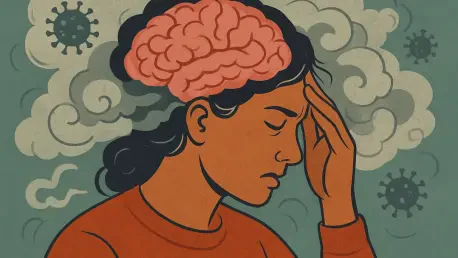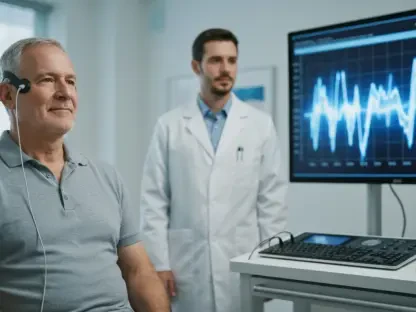For millions around the globe, Long Covid remains a persistent shadow even after the initial battle with SARS-CoV-2 has passed, manifesting in symptoms that disrupt lives in profound ways, with “brain fog” standing out as a particularly debilitating condition. This cognitive impairment, affecting over 80% of Long Covid patients, clouds memory, focus, and the ability to handle everyday tasks, often rendering them unable to work or function normally, placing a heavy socioeconomic burden on individuals and communities alike. Until recently, the biological roots of this fog remained elusive, with earlier studies noting structural changes in the brain but failing to identify specific mechanisms. However, a groundbreaking study from Yokohama City University, led by Professor Takuya Takahashi, has shifted the landscape by revealing molecular insights that could change how this condition is understood and addressed. Published in Brain Communications, this research offers a beacon of hope, linking a measurable brain component to the severity of symptoms and paving the way for potential solutions.
Uncovering the Molecular Culprit
AMPA Receptors: A Key Player in Brain Fog
The spotlight of this pioneering research falls on AMPA receptors (AMPARs), molecules in the brain that play a vital role in memory and learning processes. The study reveals a striking pattern: a widespread increase in AMPAR density across the brains of Long Covid patients compared to healthy individuals. This surge isn’t just a random anomaly; it correlates directly with the intensity of cognitive struggles such as forgetfulness and difficulty concentrating. For many patients, these symptoms have been a frustrating barrier to resuming normal life, and the discovery of this molecular link offers a tangible explanation for their experiences. It suggests that the brain’s fundamental machinery for processing information is being disrupted at a deep level, providing a critical clue to why brain fog feels so pervasive and persistent. This finding builds on existing knowledge of AMPARs’ involvement in other neurological disorders, positioning Long Covid within a broader spectrum of brain-related challenges.
Beyond identifying this molecular shift, the research underscores the significance of AMPARs as more than just a marker of dysfunction. Their increased presence hints at an overactive or imbalanced neural environment in Long Covid patients, potentially altering how signals are transmitted in the brain. This could explain why routine mental tasks become monumental challenges for those affected. Unlike previous studies that focused on visible brain changes through standard imaging, this work dives into the microscopic realm, offering a granular view of what’s going wrong. The implications are profound, as understanding AMPAR behavior could shift the narrative from merely documenting symptoms to targeting the underlying biology. For patients who have often felt dismissed or misunderstood, this validation of a physical basis for their struggles is a crucial step toward recognition and relief. It also sets a foundation for exploring whether similar mechanisms are at play in other post-viral conditions.
Linking Molecular Changes to Symptoms
A revolutionary aspect of this study lies in its use of [11C]K-2 AMPAR PET imaging, a cutting-edge technique that allows scientists to visualize and measure AMPAR density in the living human brain with unprecedented precision. This method marks a leap forward from traditional approaches, providing real-time data on how these receptors behave in Long Covid patients. The results are telling: the higher the AMPAR density, the more severe the brain fog symptoms, establishing a direct connection between molecular changes and cognitive impairment. This correlation is not just a scientific curiosity; it positions AMPARs as potential biomarkers, offering a way to objectively assess the condition rather than relying solely on patient-reported experiences. Such a tool could transform clinical practice by providing concrete evidence of brain fog’s impact.
Equally important is how this imaging breakthrough bridges a longstanding gap in understanding Long Covid’s effects on the brain. For years, the lack of specific diagnostic methods left both patients and clinicians in the dark, often leading to frustration over the intangible nature of cognitive symptoms. The ability to quantify AMPAR density with high accuracy—distinguishing Long Covid patients from healthy controls—offers a new lens through which to view this condition. It also raises intriguing questions about why these receptors increase in the first place, pointing to possible downstream effects of the initial viral infection. This discovery doesn’t just validate the reality of brain fog; it provides a measurable target for future research and interventions. As a result, the path toward diagnosing and potentially reversing cognitive decline in Long Covid patients feels more tangible than ever before.
The Role of Inflammation and Systemic Effects
Inflammation’s Connection to Brain Dysfunction
Another critical dimension of this research is its exploration of how systemic inflammation, triggered by SARS-CoV-2 infection, may exacerbate molecular changes in the brain. The study identifies a notable link between elevated AMPAR levels and inflammatory markers in Long Covid patients, suggesting that the body’s immune response plays a significant role in sustaining cognitive deficits. This connection points to a broader immune-brain axis, where inflammation originating outside the brain could influence neural function over extended periods. For many patients, this finding resonates with the lingering fatigue and malaise often accompanying brain fog, hinting at a whole-body impact from the virus. It also highlights why recovery from Long Covid isn’t straightforward, as the interplay between immune activity and brain health creates a complex barrier to normalcy.
Delving deeper, this relationship between inflammation and AMPAR density opens up a new frontier in understanding post-viral syndromes. It suggests that the immune system’s reaction to SARS-CoV-2 doesn’t simply fade after the acute phase but may leave lasting imprints on brain chemistry. This could mean that inflammation acts as a catalyst, amplifying the molecular disruptions that lead to brain fog. Such insights challenge the notion that Long Covid’s cognitive effects are purely neurological, instead framing them as part of a systemic puzzle. For researchers, this points to the need for therapies that address both inflammation and brain function simultaneously. Patients might find some solace in knowing that their symptoms stem from measurable biological processes rather than unexplained causes, reinforcing the urgency to tackle inflammation as a key driver of their condition.
A Multidimensional Perspective
By weaving together data on inflammatory biomarkers with advanced brain imaging, the study paints a comprehensive picture of how Long Covid impacts both mind and body. Brain fog, it turns out, isn’t an isolated brain issue but a reflection of broader systemic responses to infection. This multidimensional approach reveals the intricate web of interactions at play, where a viral assault on the body can ripple into cognitive dysfunction through interconnected pathways. It’s a stark reminder of the virus’s far-reaching effects, extending well beyond the respiratory system to alter fundamental aspects of brain performance. For clinicians, this perspective emphasizes the importance of looking at Long Covid holistically, rather than focusing solely on neurological symptoms in isolation.
This integrated view also sheds light on why Long Covid manifests so differently across individuals, with some experiencing severe brain fog while others face milder challenges. The interplay between inflammation and AMPAR changes likely varies based on factors like immune response intensity or pre-existing health conditions, adding layers of complexity to the condition. Such variability underscores the need for personalized medical strategies that account for both systemic and brain-specific factors. Moreover, it positions Long Covid as a condition that demands interdisciplinary research, combining insights from immunology, neurology, and molecular biology. As this multidimensional framework gains traction, it could inspire new ways to predict who is most at risk for cognitive symptoms and how best to intervene before long-term damage sets in.
Implications for Diagnosis and Treatment
A New Diagnostic Frontier
One of the most promising outcomes of this research is the potential for AMPAR density to serve as a diagnostic tool for Long Covid brain fog. The study’s imaging data demonstrates remarkable accuracy—100% sensitivity and 91% specificity—in distinguishing affected patients from healthy controls. This level of precision could revolutionize clinical approaches, moving beyond subjective patient reports to objective biological evidence. For many who have struggled to have their symptoms recognized, this offers a path to validation, ensuring that brain fog is treated as a legitimate medical condition. It also equips healthcare providers with a concrete metric to assess severity, which could guide more tailored care plans and improve patient outcomes over time.
The impact of such a diagnostic breakthrough extends beyond individual cases to broader public health strategies. With a reliable way to identify brain fog through AMPAR imaging, clinicians could better track the prevalence and progression of Long Covid’s cognitive effects across populations. This data could inform resource allocation, ensuring that support systems are in place for those most affected. Additionally, it addresses a critical gap in current medical practice, where the lack of measurable indicators often delays diagnosis and intervention. While the technology behind [11C]K-2 AMPAR PET imaging may not yet be widely accessible, its development signals a shift toward more precise tools in neurology. As access expands, this could become a cornerstone in managing Long Covid, offering clarity to millions grappling with invisible yet life-altering symptoms.
Hope for Future Therapies
Looking ahead, the study’s findings spark cautious optimism about therapeutic possibilities, particularly through drugs that modulate AMPAR activity to alleviate cognitive symptoms. Professor Takahashi and the research team stress that while these results mark a significant advance, translating them into practical treatments requires further exploration. The idea of targeting AMPARs directly offers a novel angle for drug development, potentially restoring balance to neural signaling disrupted by Long Covid. For patients, this represents a glimmer of hope that the fog clouding their minds might one day lift, allowing a return to clearer thinking and improved quality of life. It’s a reminder that science, though incremental, is steadily closing in on solutions.
Beyond pharmaceutical interventions, the research also prompts consideration of complementary approaches, such as managing systemic inflammation to indirectly influence AMPAR levels. This dual focus could lead to comprehensive treatment protocols that address both the molecular and systemic roots of brain fog. While challenges remain in refining these strategies, the foundation laid by this study is undeniable. It calls on the healthcare industry to prioritize Long Covid as a pressing clinical issue, urging investment in research and development to turn molecular insights into tangible relief. As these efforts unfold, the ultimate goal remains clear: to lessen the burden of cognitive impairment and empower patients to reclaim their mental sharpness and daily routines.









